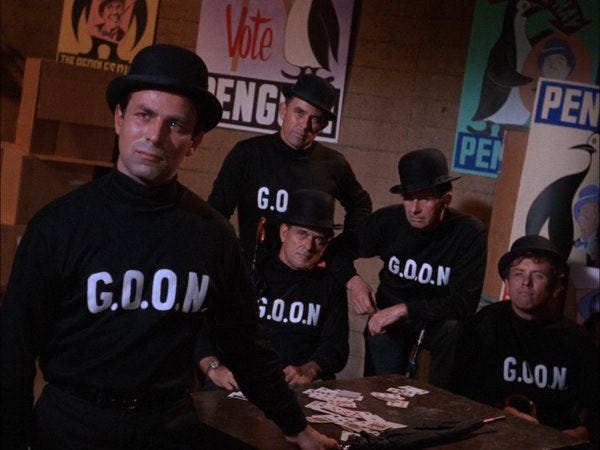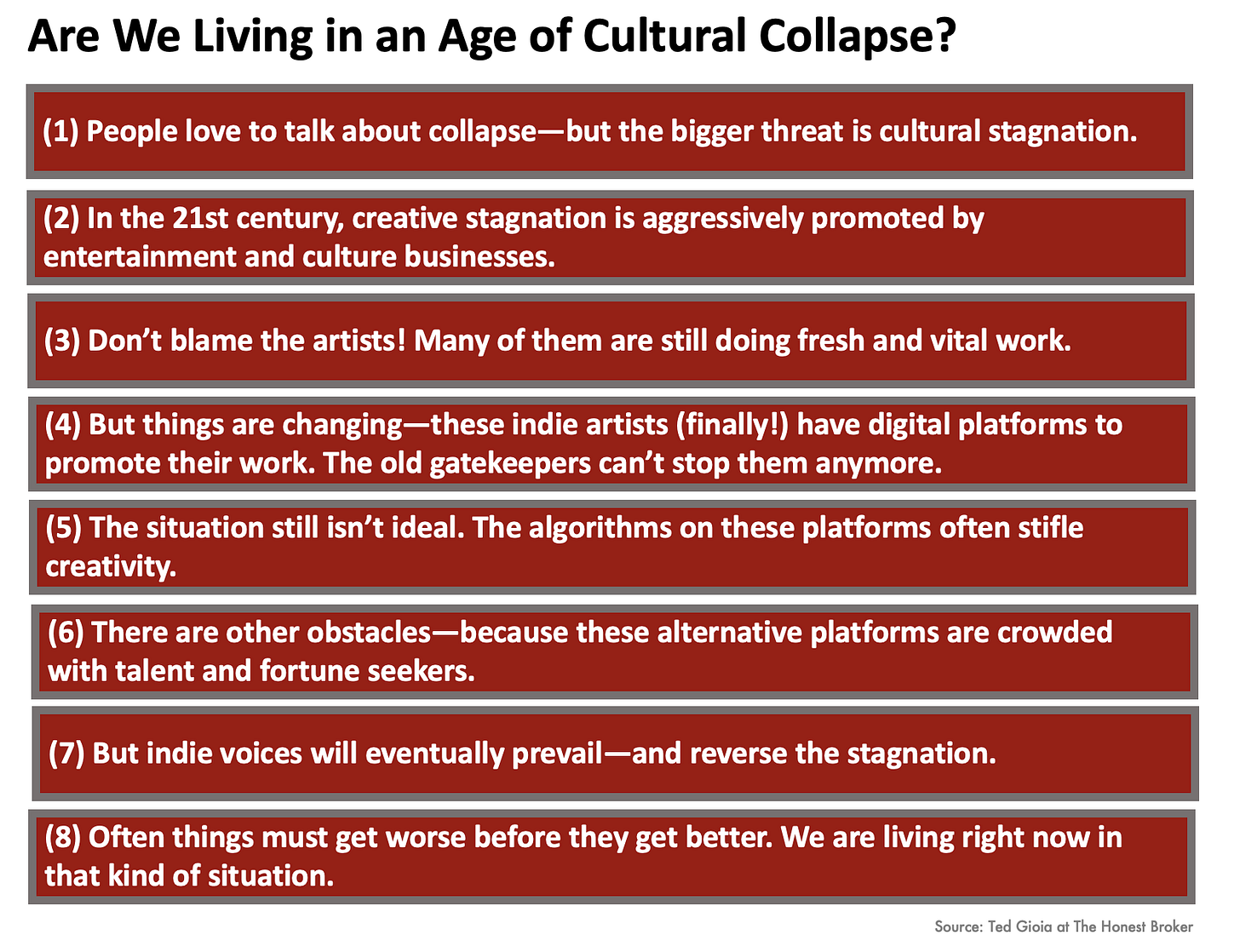Are We Living in a Time of Cultural Collapse?
Some say I believe this—but do I really?
Many articles have been written about me over the years. But I’ve never been hit with an opening sentence like the one published on Monday by The Atlantic.
Last year, I visited the music historian Ted Gioia to talk about the death of civilization.
Whoa! That makes me feel like a Bond villain.
I need some henchmen—any volunteers?
What an unexpected turnabout! For many years, I was known as an expert on music, especially jazz and blues.
But now I’ve taken on a new guise. I’m the guy you consult about the total collapse of everything.
I don’t sing the blues. I don’t write about the blues. I now deliver the blues.
If you want to support my work, the best way is by taking out a premium subscription (for just $6 per month).
I originally declined the interview request from The Atlantic. But their staff writer Spencer Kornhaber pushed back, insisting that I was an essential source for his article.
The subject was, he explained, a “pervasive suspicion that we're in an era of cultural decline, especially in arts and entertainment.”
He said that I needed to be part of the story—because everybody saw me as the decline-of-culture guy.
This caught me surprise. But I thought it over. Maybe this is why I don’t get invited to many parties anymore.
Dammit, Ted, we’re trying to have some fun here—and you keep droning on about the collapse of the Roman empire.
I eventually agreed to a phone conversation with Spencer, and that went well. And this led to him getting on a plane, and visiting me at home here in Austin.
To help him in his research, I laid out more than 40 books on a countertop in my library—these were essential works, I explained, for anyone studying social or cultural decline.
[At a future date, I will provide more details about these books, and share a reading list on—to quote The Atlantic—the “death of civilization.”]
But this begs the question: Is our culture really collapsing?
I spoke with Spencer for many hours about this subject. But only a few of my comments found their way into the finished article.
So today I’ll offer a fuller diagnosis for your benefit.
Are We Living in an Age of Cultural Collapse?
(1) People love to talk about collapse—but the bigger threat is cultural stagnation.
If you study history, you learn that total collapse is rare. But stagnation is quite common.
Stagnation is really the rule, not the exception. So it’s more likely than all the other options put together. Sometimes entire lifetimes pass by without significant cultural innovation. Go look at all those Egyptian and Chinese dynasties, and try to list the major innovations that happened in any given 25 or 50 year span.
Good luck with that.
Many of these societies took pride in their lack of change. Stagnation often comes packaged with reverence for the past. Change is avoided. Innovation is feared or punished.
Historians won’t give you much help. When I tried to learn what transpired during the twelfth dynasty of ancient Egypt—which lasted 189 years—the experts told me that it was a time of “relative stability.”
Duh!
In extreme instances, artistic styles don’t change—or change very little—over long periods.
Most of us don’t realize this, because we grew up in an era of fast-paced cultural change. But guess what? That has now stopped.
(2) In the 21st century, creative stagnation is aggressively promoted by entertainment and culture businesses.
Have you noticed that the same brand franchises keep getting recycled by Hollywood?
Of course you have. 21st century cinema is dominated by sequels, prequels, spin-offs, remakes, reboots, and various other retreads.
Hollywood hates original ideas. Or perhaps it’s more accurate to say that Hollywood fears new ideas. They want to reduce movie-making to a formula—and the easiest way to do that is to tell the same story over and over.
So they deliberately pursue stagnation. It’s their business model.
And the same thing is happening in other entertainment and culture business. The biggest new video games are also brand extensions. Spin-off TV series are everywhere. The publishing industry keeps releasing the same kind of book over and over again. The dominant formulas in music genres haven’t changed in the last 25 years.
(3) Don’t blame the artists! Many of them are still doing fresh and vital work.
Despite this stagnation, there are plenty of creative artists doing fresh work—but the system works against them.
I know this for a certainty. That’s because I listen to new music every day. And I keep finding exciting artists and songs.
But the most creative musicians are almost always hidden from view. Their music mostly shows up on homemade albums or small indie labels.
Meanwhile the major labels prefer to buy up publishing rights to old songs. Just as in Hollywood, these businesses choose stagnation. They are afraid of anything new or different—it’s too risky.
(4) But things are changing—these indie artists (finally!) have digital platforms to promote their work. The old gatekeepers can’t stop them anymore.
Not long ago, you couldn’t thrive as a musician without a record deal from a major label. Not anymore. Musicians now reach fans directly on Bandcamp or TikTok or YouTube or some other channel without gatekeepers.
This same shift has happened in almost every creative field. It’s like the Berlin Wall has fallen in the cultural sphere.
Take a look at how much Substack has shaken up the publishing and media world in just the last 24 months. Instead of stagnation, we have a healthy unleashing of creative energy and risk-taking.
These alternative platforms are our best hope for the future. And it’s not just hope, it’s reality—because these platforms are growing rapidly.
(5) The situation still isn’t ideal. The algorithms on these platforms often stifle creativity.
Algorithms also reward the familiar over the new—they are feedback mechanisms, and tend to stifle innovation. This prevents a platform like TikTok from having the positive impact it could.
But not every platform is so conformist. I have a lot of confidence in Bandcamp, Substack, YouTube, and a few other creator-boosting platforms.
YouTube is an interesting case study. It’s part of the Google/Alphabet empire of dreary mind-numbing conformity, yet somehow has managed to escape the authoritarian mindset of the rest of empire.
YouTube really does support and reward indie voices. That’s why it’s still growing at a healthy clip (unlike Apple or Disney or other purveyors of stagnation).
(6) There are other obstacles—because these alternative platforms are crowded with talent and fortune seekers.
These new platforms are filled to the brim with aspiring musicians, writers, etc. Even the most talented artists will struggle to stand out—because of all the noise.
But this is a sign of vitality.
Places like Bandcamp or Substack are exciting because so many different voices have been attracted to these freewheeling platforms. The Darwinian intensity of the fight-for-survival in these environments may not be entirely fair or dispassionate, but they will ensure that more than a few deserving individuals will get heard.
That’s why I believe that….
(7) Indie voices will eventually prevail—and reverse the stagnation.
Ross Barkan recently predicted that the future of media will be driven by Substack and YouTube. I agree with him. They are the sources of liberation and energy in an culture where old legacy players are moribund.
But other digital (and real world) businesses can also participate in this revival. They just need to avoid the authoritarian impulse, and actually support creators.
There are plenty of creative people out there. The platforms just need to stop punishing them, and instead give them a helping hand.
(8) Often things must get worse before they get better. We are living right now in that kind of situation.
I’ve learned that trends create their own demise—by pushing to extremes.
You can call this a mimetic crisis (if you’re a reader of René Girard). Or you can call it the dialectical process (if you are a Hegelian). Or you can call it the Theory of Reflexivity (if you are a student of George Soro’s The Alchemy of Finance).
Sometimes I just like to call it karma. Bad actions punish themselves, and lay the foundation for their reversal.
The name doesn’t really matter. But it’s important to understand how this actually works in the real world.
Most people fail to understand how cultural reversals occur. They borrow misleading mathematical notions—like reversion to the mean or standard deviation or some other logical concept.
But cultural reversals do not happen according to logic or math. They follow different rules—driven by emotion, psychology, and group dynamics.
The process unfolds in five steps.
All trends accelerate (because of mimetic desire—essentially people imitating other people).
The trend always goes on for longer than is reasonable—because it’s driven by emotion, not logic. It feeds on itself.
It reaches an extreme point, where the trend is now ridiculous. (How many reboots and sequels can we digest?)
At this ridiculous extreme, the public becomes disgusted with the trend. (I’m sick of all these lookalike superhero movies. Gimme a break!)
This lays the foundation for a sharp reversal. The old trend is now mocked, and something new takes its place. This is the moment when cultural innovation can happen.
Let me emphasize these final two steps—because they are essential and poorly understood:
Major trends do not end because they reach a logical conclusion—or run out of steam or lose momentum. They climax in absurdity because trendsetters push too far—and embrace crazy extremes. This is what creates momentum for the reversal.
We are living through this (steps four and five) right now.
The absurdity is everywhere. You see it in music, where record labels prefer to invest in 50-year-old songs—instead of new hits. You see it in film, where a studio dumps 36 Marvel superhero movies on the market—and then acts surprised because audiences sicken of them.
These ridiculous actions tell us that a reversal is at hand. We don’t measure that by anything logical. We measure it by the absurdity.
And that’s why I’m actually optimistic.
So I’m not a Bond villain. I’m not Dr. Evil. I’m not a doom-and-gloom naysayer.
And I don’t need any henchmen. (Thank you for the applications—we will keep them on file.)
I sharply criticize the purveyors of stagnation, and will continue to do so. But I’m confident that history is on our side.
In the near future, I’ll share the a list of experts and books on cultural decline, stagnation, and rebirth. These help me predict cycles of this sort. I learned my futurism from the experts, and they deserve to get full credit.






Last night I took the kids to see the 36th MCU film. It was preceded by 7 trailers:
Karate Kid 6
Fantastic Four 4
Mission Impossible 8
Tron 3
Jurassic Park 7
Superman 9
How to Train Your Dragon 4
I think Hollywood may be relying too much on sequels and reboots.
This cultural collapse-versus-stagnation discussion reminded me of an old comic strip I read somewhere (Okay it was Saturday Morning Breakfast Cereal) about two kinds of dystopia.
In the "predicted" dyatopia, the Book People were hiding in the forests of Canada after books had been banned and people in their denseness and credulity voted for leaders that took them right into a nuclear war. In the "more likely" dystopia, a guy walks into a bookstore and asks for good literature.
"Sorry," said the clerk, "but since the start of the 21st Century all writing slowly morphed into self-help books."
"No Shakespeare?"
"We only have 'Unleash Your Inner Shakespeare' ."